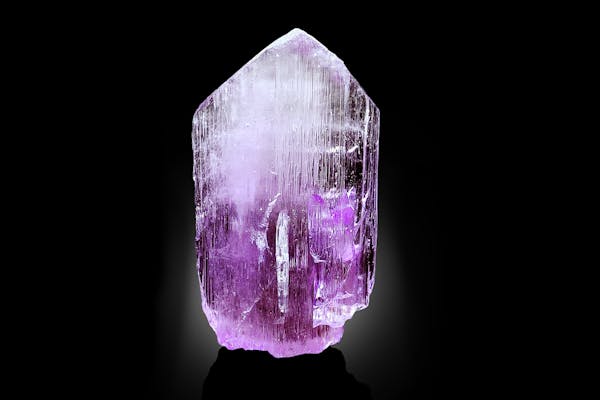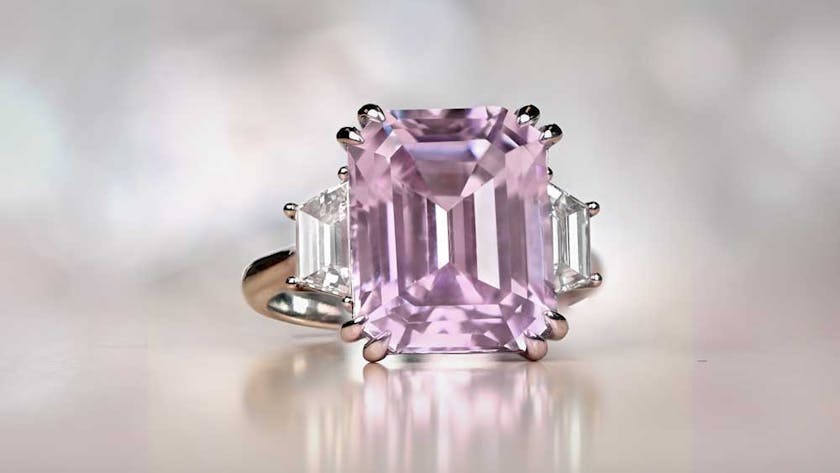
Kunzite is a beautiful gemstone that has been gaining popularity among jewelry enthusiasts and collectors alike. This delicate pink to light violet in-colored crystal was first originally discovered in California, San Diego; in the early 20th century by a renowned mineralogist named George Frederick Kunz, after whom it is named.
- History of Kunzite
- Physical Properties Of Kunzite
- Determining prices of Kunzite?
- Treatments & Enhancements
- Uses in jewelry making
- Gemstone similar to Kunzite
- Why we love Kunzite?
- Main Sources of Kunzite
- Healing Qualities of Kunzite
- How to Care for Kunzite
Kunzite gemstone belongs to the spodumene family of minerals and is known for its unique coloration, which ranges from pale pink to intense lilac. Its gentle hues are believed to emanate a calming energy that can soothe the nerves and promote emotional balance.
Furthermore, kunzite is said to have many metaphysical properties that make it ideal for use in meditation and spiritual practices. But where does kunzite come from, and what are the factors that contribute to its rarity? In this article, we will explore the origins of kunzite and the geological conditions necessary for its formation. We will also discuss some of the main sources of kunzite around the world, as well as some of the challenges involved in mining and extracting this precious gemstone.
1 HISTORY OF KUNZITE
Kunzite is a beautiful gemstone that has captured the hearts of many. Its delicate pink hue and subtle sparkle make it a popular choice for jewelry pieces. But what is the history behind this precious stone? Where did it come from, and how did it gain its popularity?
The story of Kunzite begins in California, where it was discovered by renowned mineralogist and jeweler; George Frederick Kunz in 1902, who worked at Tiffany & Co. The gemstone was named after him as a tribute to his contribution to the field of mineralogy. Kunzite is a variety of spodumene, which is a lithium aluminum silicate mineral that occurs naturally in granite pegmatites.
Initially, Kunzite was not very popular due to its limited availability and high cost of production in the mid-20th century. However, in recent years, kunzite has seen a resurgence in popularity.
2 PHYSICAL PROPERTIES OF KUNZITE
Kunzite is a young gemstone often called as pink kunzite with distinctive characteristics:
-
Mineral: Spodumene
-
Chemical Composition: LiAl(Si2O6)
-
Refractive Index: 1.660 to 1.676
-
Birefringence: 0.014 to 0.016
-
Specific Gravity: 3.18
-
Mohs Hardness: 6.5 to 7.0
Kunzite crystals are known for its pink and lilac color hues. The vivid hues are due to the presence of manganese ions that absorb light at specific wavelengths, resulting in different colors depending on their concentration levels. For instance, kunzite gemstones show vitreous color pink luster when polished and can display pleochroism; meaning it exhibits different colors when viewed from different angles. These distinctive physical properties make them highly desirable among collectors and enthusiasts alike.
3 DETERMING PRICES OF KUNZITE?
There are several factors that determine the price of Kunzite gemstones in the gem market.
-
Color: The rarest and most valuable kunzites are those with intense pink or violet hues. These colors are often referred to as “bubble gum” or “grape jelly” shades due to their vividness. In contrast, paler colors such as light pink or pale lilac are less valuable because they lack intensity.
-
Clarity: A clear and transparent stone will have a higher price tag compared to one with visible inclusions or cloudiness.
-
Cut: The best way to cut kunzite is by carefully assessing its cleavage direction before making any cuts. This requires a skilled eye and knowledge of how different types of kunzite crystals are formed. A good cut can bring out Kunzite gemstones’ pleochroism despite challenges from its 2 cleavage directions.
-
Carat Weight: Kunzite gemstones are usually sold at large size as its extremely rare to find a tiny stone. You’ll have to pay a high price just because the stone’s big. In most cases the stones range in sizes between ten carats.
4 TREATMENTS & ENHANCEMENTS
Kunzite crystal, considered one of the most beautiful gemstones on earth, has a delicate pale pink to violet hue that makes it so sought after by jewelry enthusiasts worldwide. However, not all kunzite gemstone possess this attractive tint naturally. Some undergo heat treatment to enhance their color and improve their overall appearance.
Heat treatment is a common practice in the gemstone industry, and kunzites are no exception. The process involves exposing the stone to high temperatures that can alter its color or clarity. With most kunzite,, heating it at around 200-300 degrees Celsius can deepen its pink or violet hues and remove any yellowish or brownish tint present in the stone. The duration and intensity of heat treatment depend on the specific stone’s condition, but it typically lasts a few hours up to several days. Heat-treated kunzites display more vibrant hues than untreated ones, making them more attractive to buyers.
5 USES IN JEWELRY MAKING
Natural Kunzite and Diamond Engagement Ring by Estate Diamond Jewelry
Kunzite is a precious gemstone that has been utilized in jewelry for centuries. The beautiful pink and purple hues of this gem make it a popular choice among jewelers for creating elegant and sophisticated pieces. Kunzite stone makes an excellent addition to any jewelry collection; adding a touch of luxury and glamour to any outfit.
One of the most common uses of kunzite in jewelry is as the centerpiece stone in rings, necklaces, and earrings. Its unique coloration complements both gold and silver settings perfectly; making it versatile enough to be paired with other gemstones as well.
Another popular use for the kunzite found in jewelry is as a healing stone. It’s believed to have healing properties that promote emotional healing; helping individuals overcome anxiety, calm nerves and help deal with physical stress while fostering creativity and intuition.
6 GEMSTONE SIMILAR TO KUNZITE
Kunzite is a stunning, pink-colored gemstone that has become increasingly popular in recent years. Its delicate hue and unique properties make it a sought-after choice for jewelry enthusiasts. However, despite its popularity, Kunzite is not always easy to come by. This has led many people to search for alternative gemstones with similar qualities.
One such gemstone is Morganite. Like Kunzite, Morganite belongs to the beryl family of minerals and boasts a pale pink color that ranges from almost colorless to peachy-pink gemstones. It’s often found in larger sizes than Kunzite and can be more affordable as well. Morganite is also known for its durability and hardness, making it an excellent choice for daily wear jewelry.
Another alternative to Kunzite is Pink Tourmaline. This gemstone is also known as Rubellite and comes in shades of pink from light rose to deep magenta. It is a durable stone with a hardness rating of 7-7.5 on the Mohs scale, making it suitable for everyday wear. They have an excellent clarity and brilliance similar to Kunzite but at a lower price point.
One of the most popular alternatives to Kunzite is Rose Quartz. This crystal has a soft pink color and is often associated with love and healing. Like Kunzite, Rose Quartz is also a member of the “Spodumene” quartz family but has a much lower hardness rating compared to Kunzite. Nevertheless, this gemstone remains a favorite among those who love delicate jewelry pieces.
7 WHY WE LOVE KUNZITE?
Kunzite is a popular gemstone that has captured the hearts of many users around the globe. This gem has a unique charm that makes it stand out from other gemstones. One of the reasons why Kunzite is so loved by many is its affordability. Unlike other precious stones, Kunzite can be purchased at an affordable price without sacrificing quality.
Another reason why we love Kunzite gemstone is because it is monoclinic and its crystals often take on a blade-like shape; making them look dramatic.
Moreover, the formation of kunzite typically occurs in pegmatites – igneous rocks that are formed from magma or lava. Pegmatites contain large crystals and minerals that are not commonly found elsewhere in the Earth’s crust. Kunzite forms in nutrient rich soil; when lithium-rich magma or fluids come into contact with pegmatites containing aluminum-rich minerals like feldspar or mica. As the magma cools and crystallizes over time, it creates pockets where kunzite can grow.
8 MAIN SOURCES OF KUNZITE
The main source of Kunzite gemstones is Afghanistan, where the largest and finest quality crystals are found. Other countries in Asia such as Myanmar, Pakistan, and Russia also have significant deposits of kunzite.
Brazil has also become a prominent producer of kunzite in recent years. The state of Minas Gerais accounts for the majority of Brazil’s production and boasts some of the highest-quality kunzites ever found. In Africa, Madagascar is home to Kunzite deposits that are medium to dark pink in color with excellent clarity.
In addition to these primary sources, kunzite can be found in other countries such as Mexico, Namibia, Norway, Sweden, and the United States.
9 HEALING QUALITIES OF KUNZITE
Kunzite is a beautiful and powerful gemstone that has been recognized for its healing properties for centuries. This delicate pink crystal is known to activate the heart chakra; one of the most important energy centers in the body. It helps to open up the heart to divine and unconditional love, promoting feelings of self compassion, empathy, and understanding.
The metaphysical effects of Kunzite go beyond those craving emotional healing. This unique crystal is believed to also influence physical effects on our bodies. It is said to help reduce stress and anxiety levels while promoting relaxation and deep sleep. It can also be used as a natural pain reliever for headaches, migraines, and other ailments by placing it directly on the affected area or using it in an elixir.
In addition to its emotional and physical benefits, Kunzite can also help us connect with higher realms of consciousness; promoting inner peace and eliminating negative energy.
10 HOW TO CARE FOR KUNZITE
Kunzite is a beautiful and delicate crystal that requires special care to maintain its luster and beauty. Whether you own a kunzite pendant or ring, proper maintenance is essential to keep it looking its best.
Firstly, it’s important to avoid exposing your kunzite jewelry to prolonged exposure to direct sunlight or heat as this can cause fading of the color. Secondly, always clean your kunzite jewelry in soapy water using a soft-bristled brush. Be sure not to use any harsh chemicals or abrasives as they may damage the stone. Rinse thoroughly with warm water and dry off using a soft cloth.
Additionally, avoid wearing your kunzite jewelry while engaging in activities that can potentially damage the stone such as sports or manual labor.
11 CONCLUSION
In conclusion, Kunzite is a rare and fascinating gemstone with a rich history and unique properties. Its delicate pastel colors and high clarity make it an increasingly popular choice for jewelry designers and collectors alike. Understanding its origins, physical characteristics, and care requirements can help you appreciate the true beauty of this little-known treasure.
Whether you are looking to add a new piece to your collection or simply want to learn more about gemstones, Kunzite is definitely worth exploring further. So why not take the time to discover this hidden and healing gemstones for yourself?

